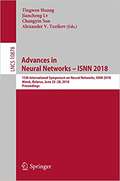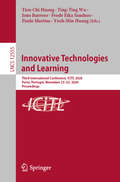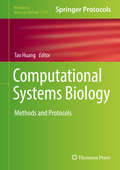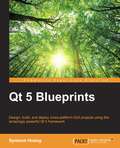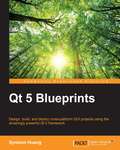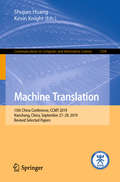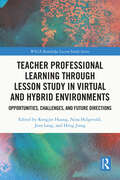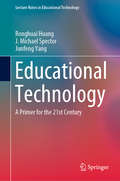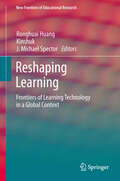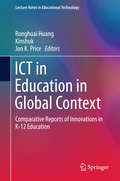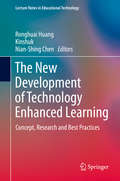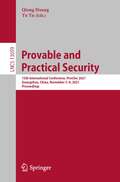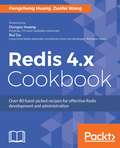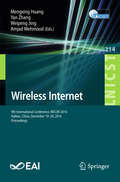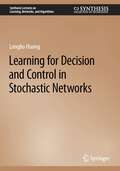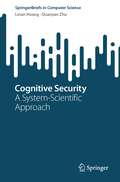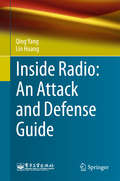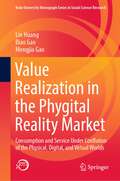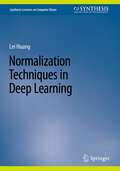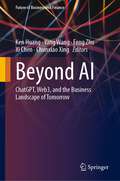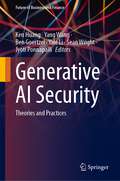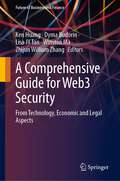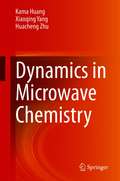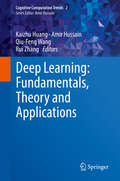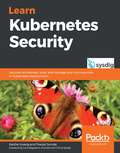- Table View
- List View
Advances in Neural Networks – ISNN 2018: 15th International Symposium On Neural Networks, ISNN 2018, Minsk, Belarus, June 25-28, 2018, Proceedings (Theoretical Computer Science and General Issues #10878)
by Tingwen Huang Jiancheng Lv Changyin Sun Alexander V. TuzikovThis book constitutes the refereed proceedings of the 15th International Symposium on Neural Networks, ISNN 2018, held in Minsk, Belarus in June 2018.The 98 revised regular papers presented in this volume were carefully reviewed and selected from 214 submissions. The papers cover many topics of neural network-related research including intelligent control, neurodynamic analysis, bio-signal, bioinformatics and biomedical engineering, clustering, classification, forecasting, models, algorithms, cognitive computation, machine learning, and optimization.
Innovative Technologies and Learning: Third International Conference, ICITL 2020, Porto, Portugal, November 23–25, 2020, Proceedings (Lecture Notes in Computer Science #12555)
by Tien-Chi Huang Ting-Ting Wu João Barroso Frode Eika Sandnes Paulo Martins Yueh-Min HuangThis book constitutes the refereed proceedings of the Second International Conference on Innovative Technologies and Learning, ICITL 2020, held in Porto, Portugal, in November 2020. The 65 full papers presented together with 2 short papers were carefully reviewed and selected from 127 submissions. The papers are organized in the following topical sections: Augmented and Virtual Reality in Education; Educational Data Mining and Learning Analytics; Emerging Issues and Trends in Education; Innovative Learning in Education; Online Course and Web-Based Environment; Technology-Enhanced Learning; Application and Design of Innovative Learning Software; and Science, Technology, Engineering, Arts and Design, and Mathematics.Due to the Corona pandemic this event was held virtually.
Computational Systems Biology: Methods And Protocols (Methods In Molecular Biology #1754)
by Tao HuangThis volume introduces the reader to the latest experimental and bioinformatics methods for DNA sequencing, RNA sequencing, cell-free tumour DNA sequencing, single cell sequencing, single-cell proteomics and metabolomics. Chapters detail advanced analysis methods, such as Genome-Wide Association Studies (GWAS), machine learning, reconstruction and analysis of gene regulatory networks and differential coexpression network analysis, and gave a practical guide for how to choose and use the right algorithm or software to handle specific high throughput data or multi-omics data. Written in the highly successful Methods in Molecular Biology series format, chapters include introductions to their respective topics, lists of the necessary materials and reagents, step-by-step, readily reproducible laboratory protocols, and tips on troubleshooting and avoiding known pitfalls.Authoritative and cutting-edge, Computational Systems Biology: Methods and Protocols aims to ensure successful results in the further study of this vital field.
Qt 5 Blueprints
by Symeon HuangIf you are a programmer looking for a truly cross-platform GUI framework to help you save your time by side-stepping the incompatibility between different platforms and building applications using Qt 5 for multiple targets, then this book is most certainly intended for you. It is assumed that you have a basic programming experience of C++ and fundamental knowledge about Qt.
Qt 5 Blueprints
by Symeon HuangIf you are a programmer looking for a truly cross-platform GUI framework to help you save your time by side-stepping the incompatibility between different platforms and building applications using Qt 5 for multiple targets, then this book is most certainly intended for you. It is assumed that you have a basic programming experience of C++ and fundamental knowledge about Qt.
Machine Translation: 15th China Conference, CCMT 2019, Nanchang, China, September 27–29, 2019, Revised Selected Papers (Communications in Computer and Information Science #1104)
by Shujian Huang Kevin KnightThis book constitutes the refereed proceedings of the 15th China Conference on Machine Translation, CCMT 2019, held in Nanchang, China, in September 2019.The 10 full papers presented in this volume were carefully reviewed and selected from 21 submissions and focus on all aspects of machine translation, including preprocessing, neural machine translation models, hybrid model, evaluation method, and post-editing.
Teacher Professional Learning through Lesson Study in Virtual and Hybrid Environments: Opportunities, Challenges, and Future Directions (WALS-Routledge Lesson Study Series)
by Rongjin Huang Nina Helgevold Jean Lang Heng JiangOffering a rich, critical investigation of how technology can be used to strengthen and promote lesson study in both virtual and hybrid environments, this edited book presents insights into the numerous challenges as well as opportunities for supporting teachers’ and teacher educators’ professional learning in such a novel setting. Providing an international perspective, research in this book highlights on the one hand the necessity of exploring how the known theoretical perspectives and methodological approaches for researching on lesson study and effective characteristics of conducting lesson study can be adapted to the new environments. On the other hand, further analysis reveals the benefits of using various advanced technologies in lesson study, the new practice of professional development of teachers and teacher educators, and also documents related issues of conducting lesson study in such complex contexts. The chapters focus on online cross-cultural lesson study; the key aspects of conducting online lesson study and the effectiveness of it. Features of facilitation and the development of facilitators for online lesson study are explored, alongside the ways in which online lesson study can help address various problems of practice such as implementing equitable teaching, facilitating student interaction in virtual environments, and migration to remote teaching in STEM. This resourceful text provides needed support to both researchers and practitioners, from primary to higher education, with special attention to both teacher and student learning.
Educational Technology: A Primer for the 21st Century (Lecture Notes in Educational Technology)
by Ronghuai Huang J. Michael Spector Junfeng YangThe aim of this book is to prepare students with knowledge and skills to understand the organizational needs and requirements of educational technology. Students should be able to use and manage both existing and emerging technologies effectively and be able to apply associated pedagogies to suit the environment, but also evaluate and manage technological advances of future and the requisite pedagogical shifts to achieve efficiency and effectiveness. The demand of educational technology has been rising steadily, primarily due to the fact that e-learning is a huge and significantly expanding world-wide industry. Commercial e-learning companies, training departments in large companies and organizations, computer software companies and educational institutions the world over employ large numbers of educational technology specialists. There is a strong demand for technologists who understand educational theories and for instructional designers and teachers who understand technologies. This book is targeted towards those who are looking for career in educational technology, instructional design, or media and information systems, or may want to continue their studies in graduate programs in learning and instructional technology, and those who are interested in becoming teacher in K-12 setting but need background in educational technology. This book will also act as a valuable resource in teacher education programs where primary focus on mainstream education and requires an authentic resource in instructional design and educational technology. Keeping in mind the varied needs of the organizations, employees and potential students, this book adopts a competency approach to learning and assessment. The themes and topics take a multi-disciplinary approach, and are aimed at preparing students for competent and innovative educational technology professionals.
Reshaping Learning
by Ronghuai Huang J. Michael Spector KinshukThis edited volume with selected papers from extinguished experts and professors in the field of learning technology and the related fields who are far-sighted and have his/her own innovative thoughts on the development of learning technology. This book will addresses the main issues concerned with the trend and future development of learning processes, innovative pedagogies changes, effects of new technologies on education, future learning content. Learning technology has been affected by advances in technology development and changes in the field of education. Nowadays we cannot afford to sense the changes and then make adaption to it. What we should do is to predict the changes and make positive and active reactions to help the trend go smoothly and in a more beneficial way. This book aims to gather the newest ideas on the frontiers and future development of learning education from the aspects of learning, pedagogies, and technologies in learning in order to draw a picture of learning education in the near future.
ICT in Education in Global Context
by Ronghuai Huang Kinshuk Jon K. PriceThis book aims to capture the current innovation and emerging trends of digital technologies for learning and education in k-12 sector through a number of invited chapters in key research areas. Emerging Patterns of innovative instruction in different context, Learning design for digital natives, Digital learning resources for personalized learning in both formal and informal educational settings, e-leadership and teacher's digital capacity will be covered in the book. This book intends to provide reference for the innovation in K-12 schools. Researchers, policy makers, school administrators and also teachers could benefit from this book on researchers and methods for innovation in K-12 schools all over the world.
The New Development of Technology Enhanced Learning
by Ronghuai Huang Kinshuk Nian-Shing ChenThe book addresses the main issues concerned with the new development of learning processes, innovative pedagogical changes, the effects of new technologies on education, future learning content, which aims to gather the newest concepts, research and best practices on the frontiers of technology enhanced learning from the aspects of learning, pedagogies and technologies in learning in order to draw a picture of technology enhanced learning in the near future. Some issues like "e-learning . . . m-learning . . . u-learning - innovative approaches," "the Framework and Method for Understanding the New Generation Students," "Context-aware Mobile Role Playing Game for Learning," " Pedagogical issues in content creation and use: IT literacy through Spoken Tutorials," "Supporting collaborative knowledge construction and discourse in the classroom," "Digital Systems for Hierarchical Open Access to Education," " Using Annotated Patient Records to Teach Clinical Reasoning to Undergraduate Students of Medicine," " Utilizing Cognitive Skills Ontology for Designing Personalized Learning Environments" and "Using Interactive Mobile Technologies to Develop Operating Room Technologies Competency" are discussed in separate chapters.
Provable and Practical Security: 15th International Conference, ProvSec 2021, Guangzhou, China, November 5–8, 2021, Proceedings (Lecture Notes in Computer Science #13059)
by Qiong Huang Yu YuThis book constitutes the refereed proceedings of the 15th International Conference on Provable Security, ProvSec 2021, held in Guangzhou, China, in November 2021. The 21 full papers presented were carefully reviewed and selected from 67 submissions. The papers focus on provable security as an essential tool for analyzing security of modern cryptographic primitives. They are divided in the following topical sections: Searchable Encryption, Key Exchange & Zero Knowledge Proof, Post Quantum Cryptography, Functional Encryption, Digital Signature, and Practical Security Protocols.
Redis 4.x Cookbook: Over 80 hand-picked recipes for effective Redis development and administration
by Pengcheng Huang Zuofei WangLeverage the power of Redis 4.x to develop, optimize and administer your Redis solutions with ease Key Features Build, deploy and administer high performance and scalable applications in Redis Covers a range of important tasks - including development and administration of Redis A practical guide that takes your understanding of Redis to the next level Book Description Redis is considered the world's most popular key-value store database. Its versatility and the wide variety of use cases it enables have made it a popular choice of database for many enterprises. Based on the latest version of Redis, this book provides both step-by-step recipes and relevant the background information required to utilize its features to the fullest. It covers everything from a basic understanding of Redis data types to advanced aspects of Redis high availability, clustering, administration, and troubleshooting. This book will be your great companion to master all aspects of Redis. The book starts off by installing and configuring Redis for you to get started with ease. Moving on, all the data types and features of Redis are introduced in detail. Next, you will learn how to develop applications with Redis in Java, Python, and the Spring Boot web framework. You will also learn replication tasks, which will help you to troubleshoot replication issues. Furthermore, you will learn the steps that need to be undertaken to ensure high availability on your cluster and during production deployment. Toward the end of the book, you will learn the topmost tasks that will help you to troubleshoot your ecosystem efficiently, along with extending Redis by using different modules. What you will learn Install and configure your Redis instance Explore various data types and commands in Redis Build client-side applications as well as a Big Data framework with Redis Manage data replication and persistence in Redis Implement high availability and data sharding in Redis Extend Redis with Redis Module Benchmark, debug, fine-tune and troubleshoot various issues in RedisWho this book is for This book is for database administrators, developers and architects who want to tackle the common and not so common problems associated with the different development and administration-related tasks in Redis. A fundamental understanding of Redis is expected to get the best out of this book.
Wireless Internet
by Mengxing Huang Yan Zhang Weipeng Jing Amjad MehmoodUbiquitous and pervasive technologies such as RFID and smart computing promise a world of networked and interconnected devices. Everything from tires to toothbrushes could soon be in communications range, heralding the dawn of an era in which today's Internet of Peoplegives way to tomorrow's Internet of Things-- where billions of objects will have the ability to report their location, identity, and history over wireless connections. Connectivity and Communication -- Anything, Anywhere, and Anytime An examination of the exciting expansion period in this research, TheInternet of Things: From RFID to the Next-Generation Pervasive Networked Systemsprovides comprehensive, technical, and practical deploying policy guidance that covers fundamentals and recent advances in pervasive networked systems. The book addresses the conceptual and technical issues that influence the technology roadmap and gives an in-depth introduction to the Internet of Thingsand its effect on businesses and individuals. Discussing case studies, experience reports, and best practice, it contains information on emerging technologies, market opportunities, and policy implications. Practical Guidance and Balanced Coverage The first book of its kind to address major new technological developments and define the Internet of Things, this text provides balanced coverage of theory and practical issues. Reflecting research trends and industry needs, itis a comprehensive technical and practical guide to recent advances in pervasive networked systems.
Learning for Decision and Control in Stochastic Networks (Synthesis Lectures on Learning, Networks, and Algorithms)
by Longbo HuangThis book introduces the Learning-Augmented Network Optimization (LANO) paradigm, which interconnects network optimization with the emerging AI theory and algorithms and has been receiving a growing attention in network research. The authors present the topic based on a general stochastic network optimization model, and review several important theoretical tools that are widely adopted in network research, including convex optimization, the drift method, and mean-field analysis. The book then covers several popular learning-based methods, i.e., learning-augmented drift, multi-armed bandit and reinforcement learning, along with applications in networks where the techniques have been successfully applied. The authors also provide a discussion on potential future directions and challenges.
Cognitive Security: A System-Scientific Approach (SpringerBriefs in Computer Science)
by Linan Huang Quanyan ZhuThis book presents the latest research in cognitive security, a rapidly emerging field that addresses the vulnerabilities in human behavior and cognition that can lead to Cyber-Physical Systems (CPS) compromise. This book demonstrates that as adversaries increasingly use manipulative and deceptive information to disrupt human cognitive processes, including sensation, attention, memory, and mental operations, humans are misled into fallacious reasoning and manipulated decisions that can lead to system-level meltdown. Cognitive security aims to protect humans from the exploitation of cognitive vulnerabilities, help them make informed decisions that are free from manipulation and undue influence, and mitigate the aggravating risk in the ensuing steps of the attacker’s kill chain. This book offers solutions that work across different fields, such as psychology, neuroscience, data science, social science, and game theory, to deal with cognitive threats. It guides the reader through the core ideas with figures, real-life examples, and case studies. Moreover, it formally defines all research questions, presents the results using mathematical theorems and proofs, and obtains insights through numerical validation. This book provides a self-contained and brief overview of essential system-scientific tools for modeling, analyzing, and mitigating cognitive vulnerabilities. The concepts of human cognitive capacities and cognitive vulnerabilities are formally discussed, followed by two case studies in the scenarios of reactive and proactive attention vulnerabilities. This book provides insights and applications on this transdisciplinary topic, with the goal of motivating future research in this emerging area and pushing the frontier of human-technology convergence. This book is a valuable reference for researchers and advanced-level students studying or working in cognitive security and related fields. It is also useful for decision-makers, managers, and professionals working within these related fields.
Inside Radio: An Attack and Defense Guide
by Lin Huang Qing YangThis book discusses the security issues in a wide range of wireless devices and systems, such as RFID, Bluetooth, ZigBee, GSM, LTE, and GPS. It collects the findings of recent research by the UnicornTeam at 360 Technology, and reviews the state-of-the-art literature on wireless security. The book also offers detailed case studies and theoretical treatments – specifically it lists numerous laboratory procedures, results, plots, commands and screenshots from real-world experiments. It is a valuable reference guide for practitioners and researchers who want to learn more about the advanced research findings and use the off-the-shelf tools to explore the wireless world.
Value Realization in the Phygital Reality Market: Consumption and Service Under Conflation of the Physical, Digital, and Virtual Worlds (Kobe University Monograph Series in Social Science Research)
by Lin Huang Biao Gao Mengjia GaoThis book is a timely and much-needed comprehensive compilation that reflects the development of research on consumption and communication in the conflation of the real and digital worlds, bringing together the current state of thinking about the phygital reality market and the cutting-edge challenges that are involved. In this book, the term “phygital reality market” is used, implying that the physical, digital, and virtual realms are fused into one to recognize and understand the market with multiple or mixed realities. The concept of the phygital reality market captures the new realities that consumers are shopping, consuming, and living, and companies are competing within the physical, digital, and virtual marketplaces. The book covers the research on consumption, service, and communication in the phygital reality market and compiles the current state of thinking, challenges, and cases having to do with the acceptance and diffusion of new technologies of phygital reality. The interest in the phygital reality market, such as omnichannel retailing integrating physical stores and online services, has grown hugely over the last two decades, particularly since the coronavirus pandemic. COVID triggered severe social and economic disruption around the world but has accelerated the acceptance and diffusion of new technologies in the phygital reality market, where the physical, digital, and virtual worlds are conflated. Versatile problem solving and new challenges are reflected in the value realization process of innovation — in other words, widespread acceptance and diffusion of devices or services that embody new technologies. The excitement and hype associated with the metaverse have highlighted the need to understand the creation and adoption of new technologies in consumption and marketing, recognition of the foundational role of new technologies in driving consumer behavior, and marketing theory and practice in value realization as a vital part of the process of digital transformation.
Normalization Techniques in Deep Learning (Synthesis Lectures on Computer Vision)
by Lei HuangThis book presents and surveys normalization techniques with a deep analysis in training deep neural networks. In addition, the author provides technical details in designing new normalization methods and network architectures tailored to specific tasks. Normalization methods can improve the training stability, optimization efficiency, and generalization ability of deep neural networks (DNNs) and have become basic components in most state-of-the-art DNN architectures. The author provides guidelines for elaborating, understanding, and applying normalization methods. This book is ideal for readers working on the development of novel deep learning algorithms and/or their applications to solve practical problems in computer vision and machine learning tasks. The book also serves as a resource researchers, engineers, and students who are new to the field and need to understand and train DNNs.
Beyond AI: ChatGPT, Web3, and the Business Landscape of Tomorrow (Future of Business and Finance)
by Ken Huang Yang Wang Feng Zhu Xi Chen Chunxiao XingThis book explores the transformative potential of ChatGPT, Web3, and their impact on productivity and various industries. It delves into Generative AI (GenAI) and its representative platform ChatGPT, their synergy with Web3, and how they can revolutionize business operations. It covers the potential impact surpassing prior industrial revolutions.After providing an overview of GenAI, ChatGPT, and Web3, it investigates business applications in various industries and areas, such as product management, finance, real estate, gaming, and government, highlighting value creation and operational revolution through their integration. It also explores their impact on content generation, customer service, personalization, and data analysis and examines how the technologies can enhance content quality, customer experiences, sales, revenue, and resource efficiency. Moreover, it addresses security, privacy, and ethics concerns, emphasizing the responsible implementation of ChatGPT and Web3. Written by experts in this field, this book is aimed at business leaders, entrepreneurs, students, investors, and professionals who are seeking insights into ChatGPT, ChatGPT Plug-in, GPT-based autonomous agents, and the integration of Gen AI and Web3 in business applications.
Generative AI Security: Theories and Practices (Future of Business and Finance)
by Ken Huang Yang Wang Ben Goertzel Yale Li Sean Wright Jyoti PonnapalliThis book explores the revolutionary intersection of Generative AI (GenAI) and cybersecurity. It presents a comprehensive guide that intertwines theories and practices, aiming to equip cybersecurity professionals, CISOs, AI researchers, developers, architects and college students with an understanding of GenAI’s profound impacts on cybersecurity. The scope of the book ranges from the foundations of GenAI, including underlying principles, advanced architectures, and cutting-edge research, to specific aspects of GenAI security such as data security, model security, application-level security, and the emerging fields of LLMOps and DevSecOps. It explores AI regulations around the globe, ethical considerations, the threat landscape, and privacy preservation. Further, it assesses the transformative potential of GenAI in reshaping the cybersecurity landscape, the ethical implications of using advanced models, and the innovative strategies required to secure GenAI applications. Lastly, the book presents an in-depth analysis of the security challenges and potential solutions specific to GenAI, and a forward-looking view of how it can redefine cybersecurity practices. By addressing these topics, it provides answers to questions on how to secure GenAI applications, as well as vital support with understanding and navigating the complex and ever-evolving regulatory environments, and how to build a resilient GenAI security program. The book offers actionable insights and hands-on resources for anyone engaged in the rapidly evolving world of GenAI and cybersecurity.
A Comprehensive Guide for Web3 Security: From Technology, Economic and Legal Aspects (Future of Business and Finance)
by Ken Huang Dyma Budorin Lisa Jy Tan Winston Ma Zhijun William ZhangWith the recent debacle of cryptocurrency exchange FTX and the crypto trading company Alameda Research, the importance of comprehending the security and regulations of Web3, cryptocurrency, and blockchain projects has been magnified. To avoid similar economic and security failures in future Web3 projects, the book provides an essential guide that offers a comprehensive and systematic approach to addressing security concerns. Written by experts in tech and finance, it provides an objective, professional, and in-depth analysis of security and privacy issues associated with Web3 and blockchain projects.This book highlights the security related to foundational Web3 building blocks such as blockchain, crypto wallets, smart contracts, and token economics, and describes recommended security processes and procedures for Web3 application development such as DevSecOps, data analytics, and data authenticity via the oracle. Moreover, the book discusses the legal and regulatory aspects of Web3 and the reasons behind the failures of well-known Web3 projects. It also contains detailed case studies of web3 projects, analyses of the reasons for their failures, and some pending legal cases.This book is an excellent resource for a diverse range of readers, with particular appeal to web3 developers, architects, project owners, and cybersecurity professionals seeking to deepen their knowledge of Web3 security.
Dynamics in Microwave Chemistry
by Kama Huang Xiaoqing Yang Huacheng ZhuThis book addresses microwave chemistry at both the physical and molecular level. Its main goal is to elaborate the highly complex scientific issues involved in the fundamental theory of microwave chemistry, and in industrialized applications in the near future.The book provides detailed insights into the characterization and measurement of dielectric properties under complex conditions, such as chemical reactions, high-temperature environments, etc. Considerable attention is paid to the theory of dynamics in microwave chemistry, from the view of both physical level and molecular level. Microwave-Material Interactions simulation is used for physical dynamical analysis, while a Microwave-Molecules Interactions methodology is proposed for molecular dynamical analysis. In turn, calculational examples are introduced for better description and validation, respectively. Lastly, the book proposes design strategies and calculational examples for large-scale application.Richly illustrated and including a wealth of worked-out examples, this book is ideal for all researchers, students and engineers who are just getting started in the dynamics of microwave chemistry.
Deep Learning: Fundamentals, Theory and Applications (Cognitive Computation Trends #2)
by Kaizhu Huang Amir Hussain Qiu-Feng Wang Rui ZhangThe purpose of this edited volume is to provide a comprehensive overview on the fundamentals of deep learning, introduce the widely-used learning architectures and algorithms, present its latest theoretical progress, discuss the most popular deep learning platforms and data sets, and describe how many deep learning methodologies have brought great breakthroughs in various applications of text, image, video, speech and audio processing. Deep learning (DL) has been widely considered as the next generation of machine learning methodology. DL attracts much attention and also achieves great success in pattern recognition, computer vision, data mining, and knowledge discovery due to its great capability in learning high-level abstract features from vast amount of data. This new book will not only attempt to provide a general roadmap or guidance to the current deep learning methodologies, but also present the challenges and envision new perspectives which may lead to further breakthroughs in this field. This book will serve as a useful reference for senior (undergraduate or graduate) students in computer science, statistics, electrical engineering, as well as others interested in studying or exploring the potential of exploiting deep learning algorithms. It will also be of special interest to researchers in the area of AI, pattern recognition, machine learning and related areas, alongside engineers interested in applying deep learning models in existing or new practical applications.
Learn Kubernetes Security: Securely orchestrate, scale, and manage your microservices in Kubernetes deployments
by Kaizhe Huang Pranjal Jumde Loris DegioanniSecure your container environment against cyberattacks and deliver robust deployments with this practical guide Key Features Explore a variety of Kubernetes components that help you to prevent cyberattacks Perform effective resource management and monitoring with Prometheus and built-in Kubernetes tools Learn techniques to prevent attackers from compromising applications and accessing resources for crypto-coin mining Book Description Kubernetes is an open source orchestration platform for managing containerized applications. Despite widespread adoption of the technology, DevOps engineers might be unaware of the pitfalls of containerized environments. With this comprehensive book, you'll learn how to use the different security integrations available on the Kubernetes platform to safeguard your deployments in a variety of scenarios. Learn Kubernetes Security starts by taking you through the Kubernetes architecture and the networking model. You'll then learn about the Kubernetes threat model and get to grips with securing clusters. Throughout the book, you'll cover various security aspects such as authentication, authorization, image scanning, and resource monitoring. As you advance, you'll learn about securing cluster components (the kube-apiserver, CoreDNS, and kubelet) and pods (hardening image, security context, and PodSecurityPolicy). With the help of hands-on examples, you'll also learn how to use open source tools such as Anchore, Prometheus, OPA, and Falco to protect your deployments. By the end of this Kubernetes book, you'll have gained a solid understanding of container security and be able to protect your clusters from cyberattacks and mitigate cybersecurity threats. What you will learn Understand the basics of Kubernetes architecture and networking Gain insights into different security integrations provided by the Kubernetes platform Delve into Kubernetes' threat modeling and security domains Explore different security configurations from a variety of practical examples Get to grips with using and deploying open source tools to protect your deployments Discover techniques to mitigate or prevent known Kubernetes hacks Who this book is for This book is for security consultants, cloud administrators, system administrators, and DevOps engineers interested in securing their container deployments. If you're looking to secure your Kubernetes clusters and cloud-based deployments, you'll find this book useful. A basic understanding of cloud computing and containerization is necessary to make the most of this book.
